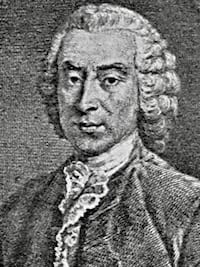Claude Pouteau
Claude Pouteau (1724–1775) was a French surgeon.
Early advocate of aseptic technique and hand-washing to reduce puerperal sepsis. Skilled lithotomist advocating a perineal approach, and slow/deliberate operation to reduce mortality (death rate 3/120)
First to describe the fracture of the lower extremity of the radius with ‘dorsal tipping of the distal fragment‘ in 1760.
Pouteau’s memoirs were published posthumously in 1783. In the second volume is recorded his description of the fracture of the distal end of the radius with ‘dorsal tipping of the distal fragment‘. Unfortunately, this work was little known outside of France and Colles was probably unaware of the findings when he published his 1814 paper
Biography
- Born on August 14, 1724 in Lyon, France
- Trained in Paris under Jean-Louis Petit (1674–1750)
- 1744 – Assistant Surgeon at l’Hôtel-Dieu, Paris
- 1747 – Chief surgeon major of Charité de Lyon
- 1753 – Entered private practice treating limb fractures and dislocations
- Died on February 10, 1775 in Lyon after suffering a fractured skull following an accidental fall down a staircase
Medical Eponyms
Pouteau fracture (1760) [Pouteau-Colles or Colles fracture]
Extra-articular fracture of the distal radius with dorsal angulation of the distal fragment. Frequently associated with an ulna styloid fracture and volar angulation of the fracture apex
In 1760, Pouteau independently described distal radius fracture rather than dislocation and hypothesised the characteristic dorsal angulation of the distal fragment.
“…mais il sera question principalement des fractures qui arrivent après des chûtes, ou la main paroit avoir fait les plus grands efforts pour en parer le danger. Ces fractures sont le plus souvent prises pour des entorses, pour des luxations incomplettes…
Il n’est peut-être point de fracture plus facile à reconnoitre au simple coup d’oeil, que celles du radius ou du cubitus, près du poignet… ses signes sont très remarquables; la moindre largeur de l’avant bras au centre de la fracture, sa dépression contre nature, par la saillie de l’une ou l’autre apophyse styloïde, & une plus grande largeur du poignet.
…lorsque le radius est cassé, sa partie inférieure est toute livrée à la force pronatrice du plan supérieur du muscle quarré”
Pouteau C, 1783;2:251-253
…but we shall concern ourselves principally with fractures that occur following falls, where the hand appears to have made the greatest efforts to stave off danger. These fractures are most often taken for sprains, for incompete luxations…
There is hardly any fracture easier to recognize at a simple glance, than that of the radius or the ulna near the wrist… its signs are very remarkable; the reduced width of the forearm at the centre of the fracture, its unnatural depression, by the protrusion of the one or other styloid apophysis, & a larger width of the wrist
…when the radius is broken, its inferior part succumbs to the pronating force from the superior plane of the pronator quadratus muscle
Pouteau C, 1783;2:251-253
Key Medical Attributions
Skilled lithotomist (removal of stones from bladder/renal tract), an operation performed without anaesthesia. It was de rigueur to perform the operation with speed and flair (see Frère Jacques Beaulieu). However Pouteau claimed a low mortality rate of 2.5%, with his emphasis on cleanliness during the procedure; and a slow and deliberate approach. Pouteau took up to 5 minutes following initial incision to remove the stones.
Asepsis: One of the first in Europe to note that hand washing reduced ‘puerperal sepsis’ in women following child birth. He noted that hospital-gangrene was not only caused by air miasma but also by direct contact, secondary to dirty instruments or hands, or hospital-made bandages. He advocated strict hand-washing over 100 years before Semmelweiss. [Pouteau, Oeuvres Posthumes 1873;3:239-250]
Cautery: In case of bleeding Pouteau advocated cautery as preferable to ligature. “We can do without the bitter sadness of seeing a lighter wound become a lethal or incurable one…” [Pouteau, Oeuvres Posthumes 1873;3:237-238]
Major Publications
- Pouteau C. Mélanges de chirurgie. Paris. 1760
- Pouteau C. Essai sur la rage. Lu dans la Séance de l’Académie des Sciences. 1763
- Pouteau C. La Taille au niveau. Mémoire sur la lithomie par l’appareil latéral. 1765
- Pouteau C. Oeuvres Posthumes de M Pouteau. Tome I, Tome II, Tome III. Paris. 1783
- Pouteau C. Memoire, contenant quelques reflexions sur quelques fractures de l’avant-bras sur les luxations incomplette du poignet sur les diastasis. In: Oeuvres Posthumes de M Pouteau. Paris. 1783;2:251-266 [Pouteau-Colles fracture]
References
Biography
- Fischer L, Touil K. Claude Pouteau (1725-1775) Chirurgien de l’Hôtel-Dieu de Lyon. 1998
Eponymous terms
- Cubry F. Des luxations de l’extrémité inférieure du cubitus compliquant la fracture du Pouteau: thèse présentée et publiquement soutenue devant la Faculté de médecine de Montpellier le 15 mars 1902
Resident medical officer in emergency medicine MB ChB (Uni. Dundee) MRCS Ed. Avid traveller, yoga teacher, polylinguist with a passion for discovering cultures.


